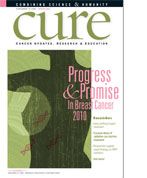Publication
Article
CURE
Details of Nipple Sparing
Things to know before deciding on a nipple-sparing mastectomy.
> There is still no consensus among doctors about nipple-sparing procedures.
> Nipple sparing is more accepted as prophylactic surgery for women at very high risk for developing breast cancer, or in cases where the tumor is small, away from the nipple and has other favorable features including negative nodes.
> The risk of recurrence and the long-term preservation of cosmetic results and sensation are not known.
> If you are interested in this option, be a good health consumer. Research your options and discuss them with your plastic surgeon and oncologist.
> An estimated 5 percent of women who get mastectomies choose the nipple-sparing option.
> Nipple-sparing mastectomy is typically covered by insurance, and it costs about the same as traditional reconstructive surgery.
> Online sources about nipple-sparing operations include Facing Our Risk of Cancer Empowered (www.facingourrisk.org), the American Cancer Society, (www.cancer.org) and The Breast Preservation Foundation (www.breastpreservationfoundation.org).





